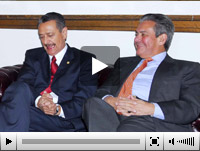- English
Lecture Series
Nineteenth Lecture - Fidel Chávez Mena - Oscar Santamaría
Nineteenth Lecture - February 16, 2007
“Reconciliation Processes in the Americas: The Case of El Salvador”
Speakers:
Fidel Chávez Mena and Oscar Santamaría, Former Foreign Ministers of El Salvador
Remarks by Dr. Oscar Santamaría, Former Foreign Minister of El Salvador (Spanish only)
...
El Salvador es hoy un país en paz y en concordia. A más de quince años de la firma de los Acuerdos de Paz, como dije en una entrevista hace algún tiempo, El Salvador es otro país. Su futuro se vislumbra distinto.
Podemos decir con verdadero satisfacción que se desmantelaron las estructuras que sostenían el conflicto y las antiguas fuerzas insurgentes se incorporaron a la vida civil, institucional, política y productiva.
Las disputas que antes pretendían resolverse en los campos de batalla, hay se resuelven en la Asamblea Legislativa del país. Hoy ya no es necesario tomar un arma para luchar por un mejor destino para El Salvador. Las instituciones democráticas son hoy un recinto de un debate plura-lista y amplio, donde la sociedad civil tiene una destacada participación en las grandes decisiones que tienen que ver con el desarrollo. Ahora estamos todos participando en la toma de decisiones para construir un futuro mejor para nuestro país, ya no hay exclusiones como en el pasado.
Los antiguos contendientes en el conflicto armado, hoy razonan sus diferencias civilizadamente en el ámbito parlamentario y dentro del marco de la libre expresión del pensamiento y la palabra. Las disputas han dejado de resolverse por la fuerza de las armas e impera el diálogo civilizado en todo el país.
Las antiguas organizaciones insurgentes, hoy son partidos políticos organizados legalmente y participan en los diferentes comicios electorales a todos los niveles y tienen sus representantes en la Asamblea Legislativa y Consejos Municipales.
Las instituciones sufrieron una profunda reforma y transformación que alteró los antiguos pará-metros del Poder; la Constitución refleja hoy un nuevo consenso y alberga un nuevo pacto social.
El país se ha desmilitarizado y el Poder civil impera sobre las autoridades militares. Hoy somos una sociedad civil y civilista.
Hay efectivamente un Nuevo El Salvador.
Full Speech by Oscar Santamaría
Remarks by Dr. Fidel Chávez Mena, Former Foreign Minister of El Salvador (Spanish only)
Acuerdos de Paz
Celebrar lo Evidente:
- Fin de la Guerra por medio de una solución política
- Fortalecimiento de la Democracia
- Elecciones libres
- Participación de todas las fuerzas políticas
- Desmilitarización.
- Fuerzas Armadas fuera de la política
- Creación de la Policía Civil
- Incorporación del FMLN al proceso
- Democratización de ciertas Instituciones.
- Creación de la PDDH
- El sistema de elección de la CSJ fortalece la independencia judicial
...
Desafíos
- Detener el proceso de repolarización del país.
- Los procesos de polarización resultan en grandes conflictos y en deterioros de las instituciones.
- Un Proceso de Alternancia Democrática.
Conclusiones
- Fortalecer las Instituciones
- Modernizar la Institucionalidad Política
- Establecer un Acuerdo de Gobernabilidad (Equilibrio en la Oferta Política y la Demanda Social)
“ARMAS SIN POLITICA Y POLITICA SIN VIOLENCIA” Fundamental en la Democracia


